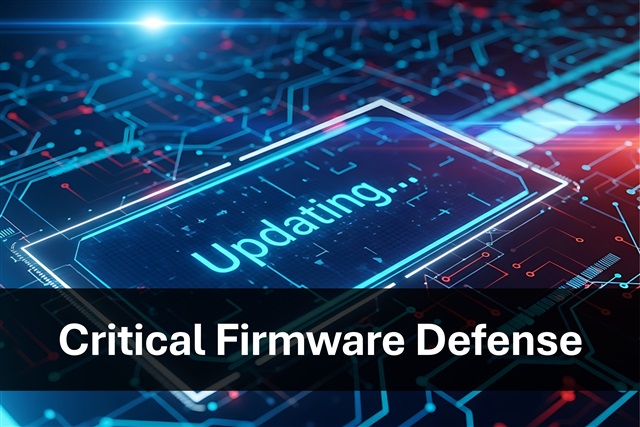As cybersecurity threats continue to evolve, attackers are no longer just targeting applications or operating systems, but are now penetrating deeper into the boot firmware layer of devices, including BIOS, UEFI, and BMC. These firmware components are responsible for initializing and verifying the system integrity during the boot process. Once compromised or embedded with malicious code, they can compromise the entire system.
Real-world incidents and attack simulations have shown that firmware attacks are highly stealthy and persistent, often eluding traditional antivirus software and OS-level defenses. The National Institute of Standards and Technology (NIST) addressed this as early as 2018 in the release of NIST SP 800-193: Platform Firmware Resiliency Guidelines, proposing a three-step framework: Detect–Protect–Recover, as the core architecture for platform firmware security.
Among these, the"Recover" mechanism has drawn significant attention. It not only mandates that a system halt upon detection of firmware anomalies, but also be capable of restoring original firmware from a secure image (such as a Golden Image)—automatically, without human intervention—thus ensuring the platform can return to a trusted state and cutting off any potential long-term malware residency.
To learn the latest cybersecurity regulations and trends, download the hardware security whitepaper for free.
Challenges in PFR Adoption: Legacy Architectures and Weak Firmware Verification
Although NIST SP 800-193 is widely recognized as a reference for governments and enterprises implementing firmware security, the practical deployment of PFR (Platform Firmware Resiliency) still faces numerous hurdles.
First, many embedded systems or server platforms rely on conventional SPI NOR Flash as firmware storage, which lacks support for key-based verification, partition control, and redundancy mechanisms, making it difficult to meet the "Protect" and "Recover" requirements defined by NIST. Even when the platform includes a Root of Trust (e.g., TPM, CPLD, BMC), vulnerabilities remain if the external memory used does not support secure image switching or key-binding mechanisms.
Common challenges include:
Firstly, firmware regions vulnerable to rollback attacks, where outdated, exploitable images are reintroduced. Secondly, the inability to separate access rights between boot-time and run-time, leading to broken access control. Thirdly, the lack of integrated verification tools and APIs requires extensive engineering effort to build verification workflows.
Unnder these conditions, the search for a secure storage component that supports the PFR framework has become a critical entry point for enhancing firmware security.
Winbond TrustME Secure Flash — W77Q: A Secure Memory Fully Supporting PFR
To address the above challenges, Winbond's TrustME Secure Flash — W77Q series offers a solution specifically designed for platform firmware security and recovery. It allows for fast deployment of the NIST PFR-required protection and automatic recovery features without altering the main platform architecture.
Dual Images with Secure Verification—Seamless Auto-Recovery Deployment
The W77Q integrates both a Primary Image and a Recovery Image, supporting secure verification mechanisms and auto-switching logic. When the primary firmware image is corrupted or fails verification, the Root of Trust controller (e.g., BMC or CPLD) can trigger a switch to restore the system to the Golden Image. This entire process requires no additional software or CPU intervention, fulfilling the "unattended, automatic recovery" requirements of PFR.
Moreover, the mechanism complies with the Detect-Protect-Recover architecture outlined in NIST SP 800-193, and can be integrated with major platform vendors' boot verification logic, establishing a full Chain of Trust from chip initialization to firmware validation.
Multi-Level Access Control and Key Binding to Strengthen Firmware Integrity
W77Q supports partitioning and key-based access control, allowing different keys and permissions to be configured for each firmware region (e.g., Bootloader, UEFI, BMC). This prevents unauthorized access and tampering. It also supports rollback prevention and restricts firmware updates to authorized controllers only, significantly reinforcing platform firmware integrity verification.
Modular Integration and Development Support—Accelerating PFR Implementation
The W77Q Secure Flash not only strengthens hardware-based firmware protection but also provides complete software development and validation support to help device manufacturers accelerate PFR deployment:
Offers ready-to-integrate verification API interfaces and reference designs
Provides boot verification parameters and switching logic in coordination with Root of Trust controllers (e.g., BMC, CPLD)
Delivers test reports and certification documents compliant with NIST SP 800-193 and ISO 26262
The Winbond W77Q Secure Flash is pin-to-pin compatible with existing SPI Flash devices, requiring no hardware changes, greatly reducing implementation costs.
For applications like server motherboards, 5G base stations, industrial control systems, or automotive ECUs, W77Q presents an ideal solution for quickly realizing platform firmware recovery mechanisms and meeting security compliance requirements.
To learn more about Winbond's advanced security solutions, visit Winbond's website or contact Winbond directly, or download the latest Hardware Security White Paper.
